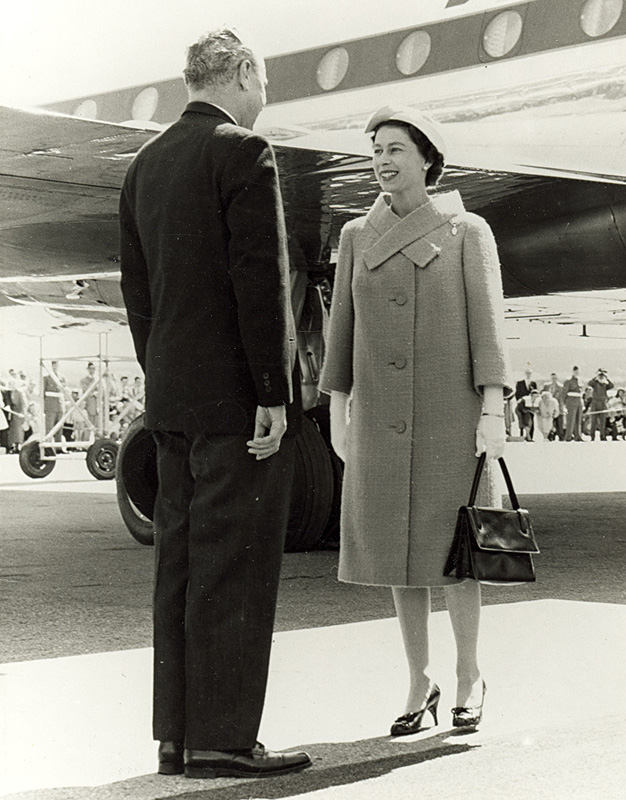John Diefenbaker éprouve un profond respect pour la monarchie et il défendra avec passion le système parlementaire britannique pendant toute sa carrière politique. Toutefois, l'époque où il est Premier ministre (1957-1963) coïncide à une période pendant laquelle les liens avec la Grande-Bretagne s'érodent et où le Canada commence à se rapprocher des États-Unis. Malgré cela, son amour de la tradition britannique se manifeste dans bon nombre de ses politiques et lors de ses rencontres avec la Couronne.
Pendant tout son mandat de Premier ministre, des changements symboliques ont lieu dans la politique étrangère du Canada qui s'éloigne du Royaume-Uni. La crise du canal de Suez de 1956-1957 a constitué une faille dans les relations canado-britanniques, le Canada décidant de jouer le rôle de gardien de la paix dans le conflit avec l'Égypte plutôt que d'appuyer les troupes britanniques en guerre contre ce pays. Toutefois, du point de vue de l'économie, le gouvernement Diefenbaker fait pression, à ses débuts, pour élargir les accords commerciaux avec la Grande-Bretagne, afin de détourner jusqu'à 15% des dépenses commerciales du Canada aux États-Unis vers le Royaume-Uni. Si Diefenbaker avait espérer encourager la Grande-Bretagne à maintenir de solides relations commerciales avec les pays du Commonwealth, les accords finissent par s'avérer économiquement irréalisables pour le Canada et les négociations cessent.
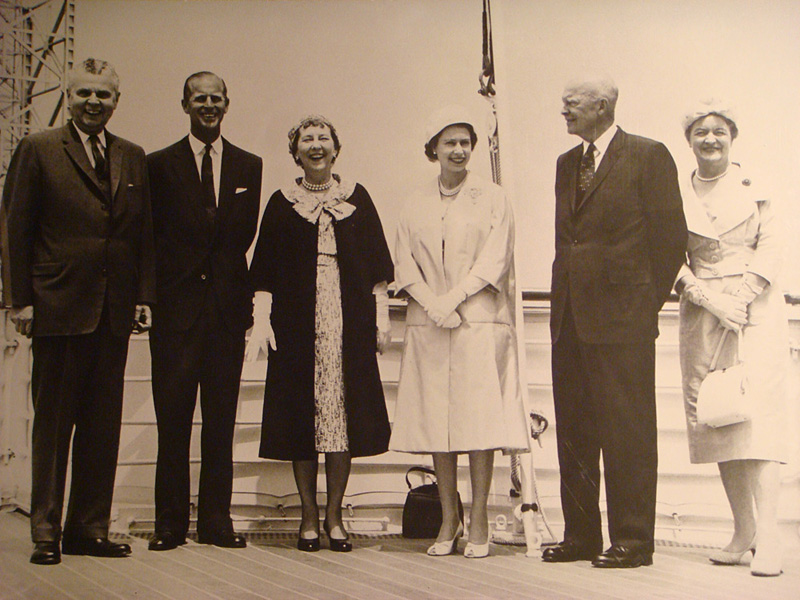 |
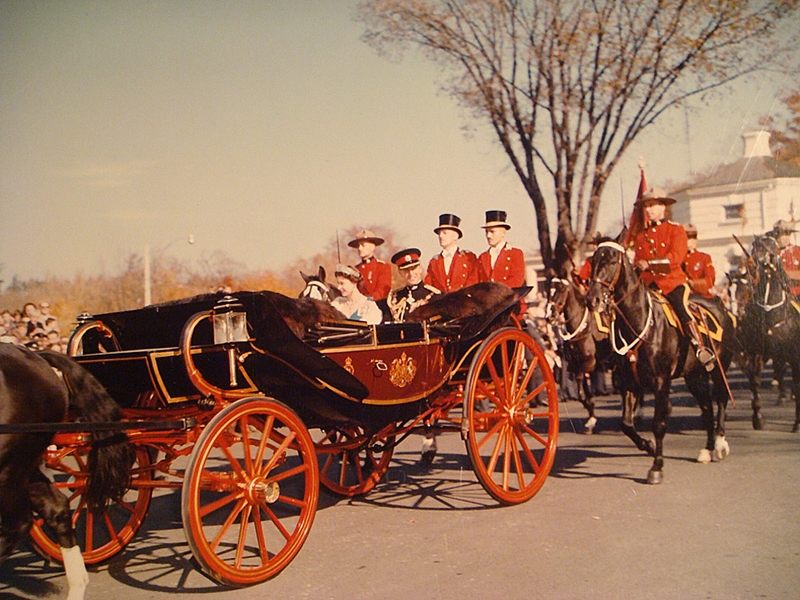 |
La profonde loyauté que Diefenbaker éprouve envers la Reine en tant que chef d'État du Canada est particulièrement apparente pendant les visites de cette dernière. En 1957, année où Diefenbaker entre dans ses fonctions de Premier ministre, la reine Elizabeth II lit le discours du Trône et ouvre le Parlement le 14 octobre. C'est la première fois que des caméras de télévision font leur apparition dans la Chambre des communes et au Sénat car Diefenbaker tient tout particulièrement à ce que la CBC diffuse le discours dans tout le pays. Le voyage royal de 1959 lui apportera une autre occasion de prouver son allégeance envers la monarchie britannique et de raffermir son importance pour les Canadiens. La Reine visite le Canada pendant 45 jours avant de faire un bref séjour aux États-Unis, à titre officiel de reine du Dominion du Canada. Après la visite d'été de la reine, Diefenbaker recommandera personnellement un autre monarchiste constitutionnel fervent, Georges Vanier, pour le poste de gouverneur général - recommandation qui portera ses fruits.
Pour Diefenbaker, l'Unifolié est un drapeau qui manque de respect envers la tradition monarchique britannique et, pendant le Débat sur le drapeau, il maintient que seul le Red Ensign peut reconnaître adéquatement l'histoire du Canada au sein de l'Empire britannique. Son amour des symboles traditionnels de l'autorité britannique est bien connu des Canadiens. En 1964, Diefenbaker, qui est alors Chef de l'opposition, défend passionnément le Red Ensign, et s'oppose à l'Unifolié que propose le Premier ministre Lester B. Pearson.
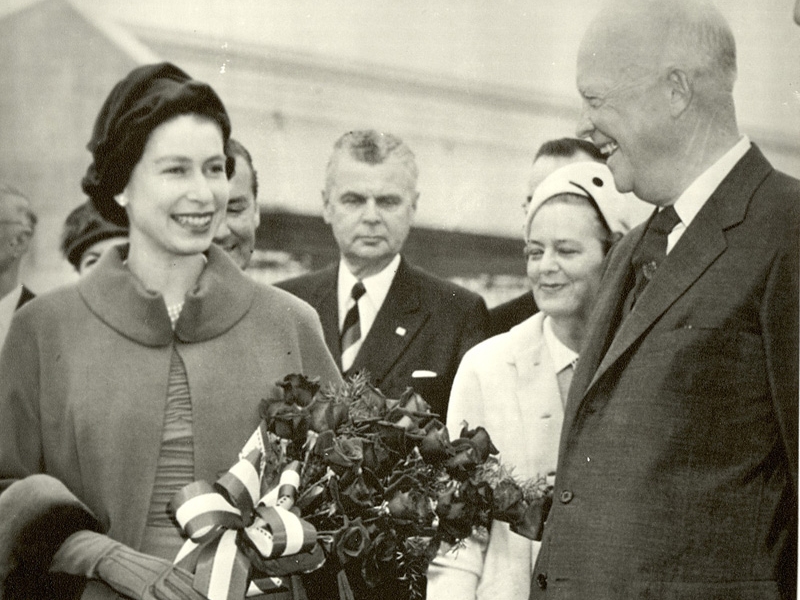 |
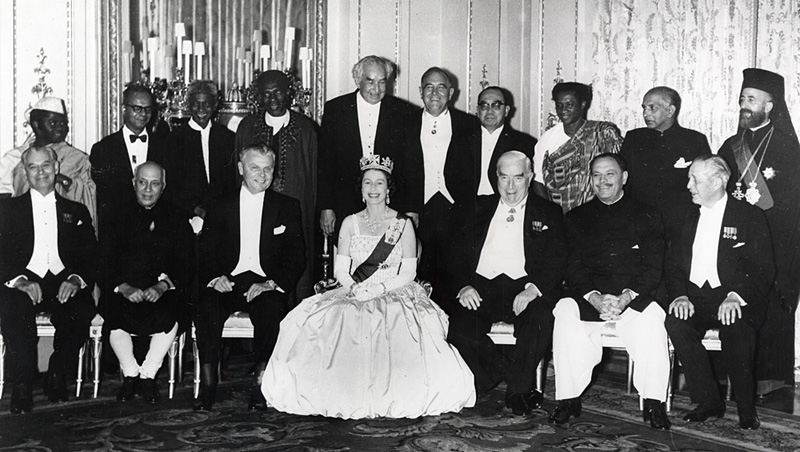 |
Bien que les traditions représentées par la Couronne reçoivent historiquement l'appui des conservateurs, la majorité des politiques actuels craignent moins l'influence américaine au Canada. L'enthousiasme de John Diefenbaker pour la monarchie britannique en est venu à représenter un torysme du passé. De nos jours, au Canada, la plupart des conservateurs ont plus d'affinité avec l'Amérique qu'avec le Commonwealth et ses valeurs culturelles des années cinquante. Et pourtant, la place de la Monarchie au Canada a été réaffirmée dans la Loi constitutionnelle de 1982, qui a permis le rapatriement de notre constitution de la Grande-Bretagne. Tout changement à la position de la Reine ou à celle de ses représentants au Canada (le Gouverneur Général et les lieutenants-gouverneurs) requiert dorénavant le consentement unanime du Sénat, de la Chambre des communes et des assemblées législatives de toutes les provinces.
 |
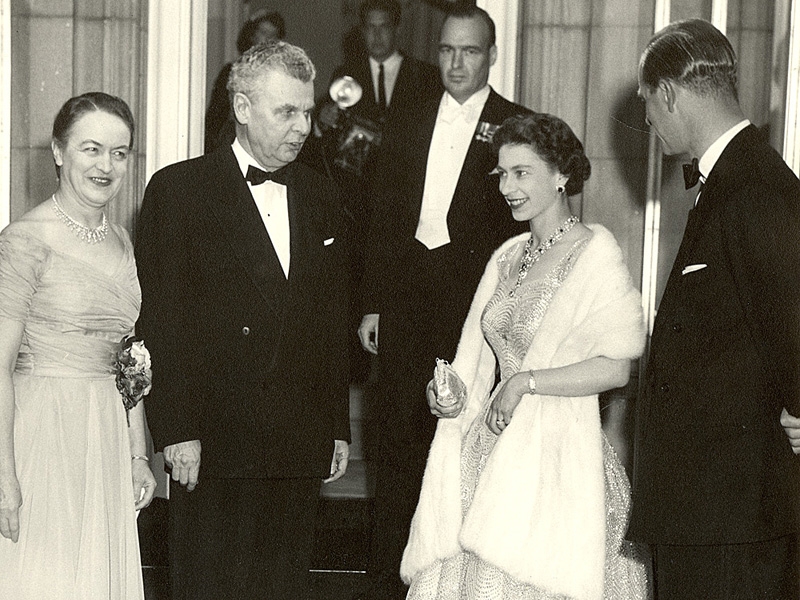 |
Documents
SECRET
August 12th, 1957
MEMORANDUM FOR THE PRIME MINISTER:
When we returned from London about a month ago, you asked me to have prepared a memorandum on the possibilities and means of diverting some 15% of Canadian imports from the United States to imports from the United Kingdom.
In discussion with Mr. Fleming and Mr. Churchill and officials in connection with the Commonwealth trade conference preparations, this problem was assigned to the Department of Finance. They have worked on it intensively and have revised their original paper to take into account comments from Trade and Commerce and External Affairs. They have now furnished me with their revised paper which I attach hereto.
The memorandum makes clear there are many serious difficulties. The pattern of our trade reflects far more than measures of commercial policy and indeed the latter have hardly been a dominant influence in the past decade. Consequently, to divert as much as 15% in the way considered would require quite drastic action.
You may like to think of having some study somewhat along these lines prepared in a form that could be published or that could form the basis of a detailed speech by one of your colleagues. It seems to me there would be some value in a good public understanding of the nature of the problems involved here. The matter of timing, however, is a very substantial one and perhaps it would be better to do this in Parliament on a suitable occasion.
R.B.B.
Press Release – For Immediate Release
Office of the Prime Minister - Canada
October 16, 1957
The Prime Minister, the Right Honourable John G. Diefenbaker, sent the following message today to Her Majesty The Queen aboard the R.C.A.F. C-5 aircraft enroute to Williamsburg, Virginia:
“AS YOUR MAJESTY AND PRINCE PHILIP LEAVE OTTAWA TO VISIT THE UNITED STATES OF AMERICA, I SEND YOU WITH HUMBLE DUTY A MESSAGE OF LOYALTY AND LOVE FROM ALL CANADIANS.
DURING THIS HISTORIC STAY, YOUR MAJESTY HAS STRENGTHENED IN US ALL OUR PRIDE IN CANADA AND IN CANADA’S QUEEN.
IT IS WITH HIGH HOPE THAT YOU WILL COME TO US SOON AGAIN THAT I BID YOU AU REVOIR; MAY GOD BLESS YOUR MAJESTY AND PRINCE PHILIP"
019082
SECRET
Ottawa, September 7, 1957.
MEMORANDUM FOR THE MINISTER
Royal Visit -
Television Programme on Sunday evening
As you may recall (our memorandum of August
30), you were to discuss with the Governor-General
the question of the Queen's speech on the Sunday
evening.
We have prepared in the Department the
attached text. You will see that paragraphs 1,
2, 3 and 7 are repeated in French. If this were
done, and given the speed at which the Queen
speaks, this material would provide a television
address of approximately ten minutes.
If you consider that the text is suitable
I could pass it on to Lionel Massey for onward
transmission to the Queen.
DRAFT
019083
SECRET
Ottawa, September 9, 1957.
I am happy to be in Canada again. In 1951 Prince
Philip and I had the opportunity of seeing much of this
country and meeting many of you. On the present visit
my stay will be short, so I welcome the more the opportunity
of speaking to you in your homes, as I have been able
to do before on Christmas morning.
2. Near where I am sitting in Rideau Wall the ageless
Ottawa river speaks, as it winds its way past the Capital, of
the early march of Canadian history; and embraces on its
shores the two great cultures, the combination of which
forms one of the greatest assets of this country.
3. Je suis heureuse de me trouver de nouveau au Canada.
En 1951 le prince Philippe et moi-meme avons eu l’occasion
de voir une bonne partie de ce pays et de rencontrer un
grand nombre d’entre vous. Cette fois mon sejour sera
de courte duree et c'est pourquoi j'apprecie tellement
l’occasion qui m’est offerte de vous parler dans
l‘intimite de vos foyers, comme j’ai pu le faire deja
le matin de Noel.
4. Non loin d’ou je suis en ce moment a Rideau-Hall,
la riviere des Outaouais, en serpentant le long de la
capitale, nous rappelle les premieres heures de l’histoire
du Canada; ses rives sont marquees par les deux grandes
cultures, dont le melange forme l’une des plus grandes
richesses de ce pays.
2.
019084
5. Canada has been much blessed by Providence with
wide acres, great forests, plentiful fisheries, and riches
below the soil. But without the energies and skills of
the men and women of the country, these would form no
more than a promise. This is a busy and a prosperous
land with great cities and many industries, but it is one,
too, that has not neglected the spiritual and intellectual
values. This morning I worshipped in Christ Church
Cathedral; and this afternoon I saw the pattern and
colour of the Gatineau Hills in autumn. Religion and
beauty are woven into life in Canada.
6. La Providence a pourvu le Canada genereusement de
vastes espaces, de grandes forets, d’abondantes pecheries
et d’un riche sous-sol. Mais sans l’energie et les
talents des habitants du pays, ces dons ne seraient
qu’espoir. Terre active et prospere, ou s’elevent de
grandes villes et de nombreuses industries, le Canada
n’en oublie pas pour autant les valeurs spirituelles et
intellectuelles. Ce matin j’ai pris dans la cathedrale
Christ-Church; cet apres-midi j’ai vu les collines de la
Gatineau dans leur splendide parure automnale. Religion
et beaute s’entrelacent dans l’existence des Canadiens.
7. Tomorrow I shall take my part, as did my father, in
the proceedings of Parliament, the orderly and democratic
means by which Canadians seek to find just and effective
solutions to the problems of the national and international
communities.
8. In many continents, in many capitals, Commonwealth
parliaments perform their tasks of striving toward the
goals of freedom, of peace, and of human well-being.
3.
019085
These are amongst the bonds which draw together the many
countries of the Commonwealth. We are not an exclusive
society: we exclude only the forces of tyranny and
aggression. Developed in freedom and fashioned by common
agreement and understanding, the modern Commonwealth is
made up of many peoples and races. But it is no accidental
or temporary grouping of countries, for it stands for
lasting purposes and ideals.
9. Speaking as I do now to my fellow Canadians,
I like to recall the particular ties between the peoples
of Canada and of the United Kingdom. These, for many of
you, are of tradition and ancestry; for a11 of you, of
problems shared and perils met; of common hopes and ideals.
10. I look forward to returning to Canada next year
to open the great St. Lawrence Seaway. I am happy to be
with you now and to give to you -- all of you, from sea
to sea -- my best wishes for your own happiness and for
the continued well-being of Canada.
11. J'envisage avec plaisir la perspective de
revenir l’an prochain pour inaugurer la grande voie
maritime du Saint-Laurent. Je suis heureuse de me trouver
au milieu de vous et de vous offrir, a tous d’un ocean
a l’autre, mes meilleurs voeux de bonheur personnel et de
prosperite nationale.
Office of the Prime Minister
Canada
Press Release Ottawa, July 9, 1957
Announcement
The Prime Minister, the Honourable John Diefenbaker, announced this afternoon that Her Majesty the Queen had today graciously consented to open the first session of the Twenty-third
Parliament of Canada on Monday, October 14th.
"I am confident that all parties in Parliament will welcomes this unique opportunity to have Her Majesty open our Parliament and greet us as we take up our duties there", Mr. Diefenbaker said, "It will be the first occasion in our history when the Sovereign has personally presided over the opening of Parliament in Canada, It seems wholly appropriate that this historic event should take place on our Thanksgiving Day, which will make it possible for many more Canadians to see Her Majesty on this occasion than would otherwise be the case.”
Her Majesty will arrive in Canada on the afternoon of Saturday, October 12th, and will leave Ottawa for the United States on the morning of Wednesday, October 16th. In view of the shortness of the Queen’s stay in Canada, it will not be possible for Her to visit any place other than Ottawa.
The usual formal proclamation on calling Parliament together on October 14th for the despatch of business will be issued in due course,
Office of the Prime Minister
Canada
Press Release – For Immediate Release
October 17, 1957
The Prime Minister, the Right Honourable John G. Diefenbaker, announced today that as a result of recent Canadian-United Kingdom discussions in Ottawa, a trade mission from Canada will arrive in the United Kingdom on November 22 for a visit extending to December 18th. The broad purposes of the mission will be to promote increases in the trade between Canada and the United Kingdom.
The leader of the mission will be the Honourable Gordon Churchill, Minister of Trade and Commerce. Mr. James S. Duncan, C.M.G., Chairman of the Dollar Sterling Trade Council will be the deputy leader. The trade mission will include leading representatives of business, industry, labour, agriculture and other primary production from all areas of Canada. Some fifty persons will be members of the mission which will be more fully representative of all Canadian economic interests than any comparable mission which has hitherto been organized.
Stamped: “Seen by John G. Diefenbaker”
Cunard Line
R.M.S. “Carinthia”
15th July 1959
My dear Prime Minister,
We have had a very good crossing, a calm sea without much sunshine however. I think it was wise to leave Canada as the portion there was getting a bit difficult.
Before going further I wish you to know that I am [illegible] on our orders with regard to the return to Canada. The alternatives appear to be
- To remain here until the official announcement is made and then to go back without delay to see Mr. Massey about staff etc.
- To stay here until Her Majesty returns to England if it is her desire to see me before I take up the appointment. May I make bold to ask you to inquire of the Queen what her wishes are in this respect.
I would be grateful if, after the announcement is made, it would be possible for you to cable me you views of the course I should follow.
With kindest remembrances, believe me, dear Prime Minister,
Yours very sincerely,
Georges P. Vanier
Either of the following addresses will reach me
Canada House or
Hotel Rembrandt
Cromwell Road
London
S.W.7.
Canada's French-Speaking Victory
Two nations with one government - that is Canada, the country that "could not be," and is.
One monarchy with seemingly contradictory functions - that is the regime that Queen Elizabeth heads.
British and French live side by side without mingling in Canada. Monarchies and republics stand shoulder to shoulder in the British-led Commonwealth of Nations, with a Queen at their head.
Now to these crosscurrents add a new one: Queen Elizabeth, in Britain the defender of a Protestant faith, approving as her Viceroy in Canada a noted Roman Catholic.
There are other paradoxes in the naming of General George Philias Vanier to be Governor-General of the one-time Dominion, now a fully independent nation in a vast commonwealth. One is that he belongs to French-speaking Canada but was appointed by a Prime Minister, Mr. John Diefenbaker, who is perhaps more than usually pro-British among Canadians.
General Vanier's appointment is another milestone on the long march of French Canadians toward equality in fact as well as theory with the Canadian Anglo-Saxons. That some of the latter seem inclined to oppose the gains of their French-speaking countrymen is not a sign of opposition to equality itself, however, but of apprehension. Some of the Anglo-Saxon Canadians fear that the basis of equality and responsible government that has been preserved under British institutions in Canada may be lost in a gradual acquisition of political power by a community which employs religion, language, and culture as bulwarks against national fusion and allegedly as instruments for exacting privilege from the rest of the population.
However, Canada has had two French-speaking Prime Ministers. They left records of great national service. They are honored today by both Canadas, which are nearer to being one because of them. General Vanier seems to belong in their company. His appointment should help French-speaking Canadians to identify their interests more closely with those not only of Anglo-Saxon Canada but of Britain and the Commonwealth.
094344
INSTALLATION OF THE GOVERNOR GENERAL
His Excellency Major-General Georges P. Vanier, D.S.O., M.C., C.D., was installed as Governor General and Commander-in-Chief of Canada at a stately ceremony in the Senate Chamber on Tuesday, September 15.
The Governor-General Designate and Mmme [sic] Vanier arrived in Ottawa by train from Montreal on Monday evening, and were met by the Prime Minister, the Right Honourable John G. Diefenbaker and Mrs. Diefenbaker. Later on Monday evening, the Prime Minister gave a dinner in honour of the Right Honourable Vincent Massey, C.H., who retired as Governor General on Major-General Vanier's installation.
Mr. Massey left Ottawa by train for his home, Batterwood House, at Fort Hope, Ontario, an hour before the installation of his successor.
The First Battalion, Regiment of Canadian Guards, provided the Guard of Honour for the Installation of General Vanier.
On their arrival at the Parliament Building, the Prime Minister conducted General and Mme Vanier to the Senate Speaker's Chambers, and from there, a procession composed of members of the Governor General's Household and with the Chairman and Chiefs of Staff in attendance, conducted General and Mme Vanier to their places at the foot of the dais in the Senate Chamber.
The Ceremony commenced with the reading of General Vanier's Commission of appointment, signed by Her Majesty The Queen in Halifax on August 1, at the conclusion of her tour of Canada.
The Chief Justice, Hon. Patrick Kerwin, administered the three oaths of office--theoath [sic] of allegiance, the oath of office of Governor General, and the oath of office as Keeper of the Great Seal of Canada. Following the signing of the oaths, General Vanier took his place on the Throne, and, after curtsying to him, Mme Vanier took her place on his left.
094345
The new Governor General then signed and sealed his first xxxxx Proclamation, bringing his Commission of appointment into effect. When the Proclamation was read, the band of the Royal Canadian Ordnance Corps, Montreal, played the Royal Salute, and a 21-gun artillery salute was fired from Nepean Point as the Governor General's standard was raised on the Peace Tower.
Prime Minister Diefenbaker, who sat during the ceremony at the head of the council table in front of the xxx dais, spoke of the significance of the installation ceremony, and the distinction that Major-General Vanier brought to the office of Governor General. He expressed best wishes on behalf of the government and people of Canada to Their Excellencies for their term of office.
On his departure from Ottawa, Mr. Massey was accorded a Royal Salute by the First Battalion Canadian Guards at the Union Station, and said farewell to the Prime Minister and Mrs. Diefenbakers, to members of the Cabinet and their wives, to the Chief Justice and Mrs. Kerwin, and the dean of the diplomatic corps, His Excellency Francis Lacoste, Ambassador of France.
NNNNQ
OTTO10
LDM 04 /04
FM EMBPARIS AUG4/60 UNCLAS
TO TT EXTERNAL 888 FM LDM
FOLLOWING FOR PRIME MINISTER FROM GEN VANIER
YESTERDAY MY WIFE AND I FLEW TO LDN FOR LUNCHEON WITH THE QUEEN TO WHOM I CONVEYED ON YOUR BEHALF THE MSG OF HUMBLE DUTY AND RESPECTS FOR WHICH HER MAJESTY THANKS YOU. LEAVING TODAY FOR VEZELAY IN BURGONDY AND RETURN TO PARIS ON 19TH FOR LUNCHEON WITH GEN DEGAULLE ON 20TH AND SAIL FROM LE HAVRE ON 24TH IN SS IVERNIA.
WARMEST REMEMBRANCES FROM BOTH OF US TO YOU AND TO MRS DIEFENBAKER.
0411102
GR75A

